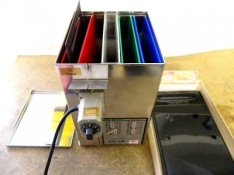Ok, so I'm down to a few solutions. Due to space, huge trays (whether purchased or homemade with plywood and plastic sheeting) is out of the question. I have a hard enough time fitting 16x20 trays on my wet table. What I am considering is:
1. hand-rolling (like a scroll) the paper back and forth in wallpaper wetting trays.
2. The Deville system (more advanced, mechanical version of the wallpaper wetting trays).
3. Building a big slot processor similar to the Nova processor.
With that said, I'm a little confused as to the actual mechanics of hand-rolling. I've read numerous descriptions online, but I am a photographer and rely on visuals more than text. I can't seem to find a video anywhere, so if anyone knows where I can find some visual information to go along with the text, I'd really appreciate it.
The Deville system looks nice, however, likely very expensive, and again, there are few resources out there to deconstruct and DIY. Also, the same problem exists with the Nova Slot processor. I'd love to DIY one of these with thick acrylic or heavy plastic, but I'm struggling to wrap my mind around how the device actually works. Has anyone build their own slot processor?
Again, with building my own slot processor, I am concerned about the pressure the liquid places on the acrylic walls, and I have no drainage in my darkroom if disaster struck. What I am considering is something akin to the FOTOCELL MINI MIZER found on
http://www.secondhanddarkroom.co.uk/. It looks to be exactly what I'm looking for, but much smaller. A metal container with heating element to allow for color processing and to hold all the chemical containers together in the event that disaster does strike and one of the containers collapses. Has anyone had any luck creating something like this, or has any advice to create this?
View attachment 93303











